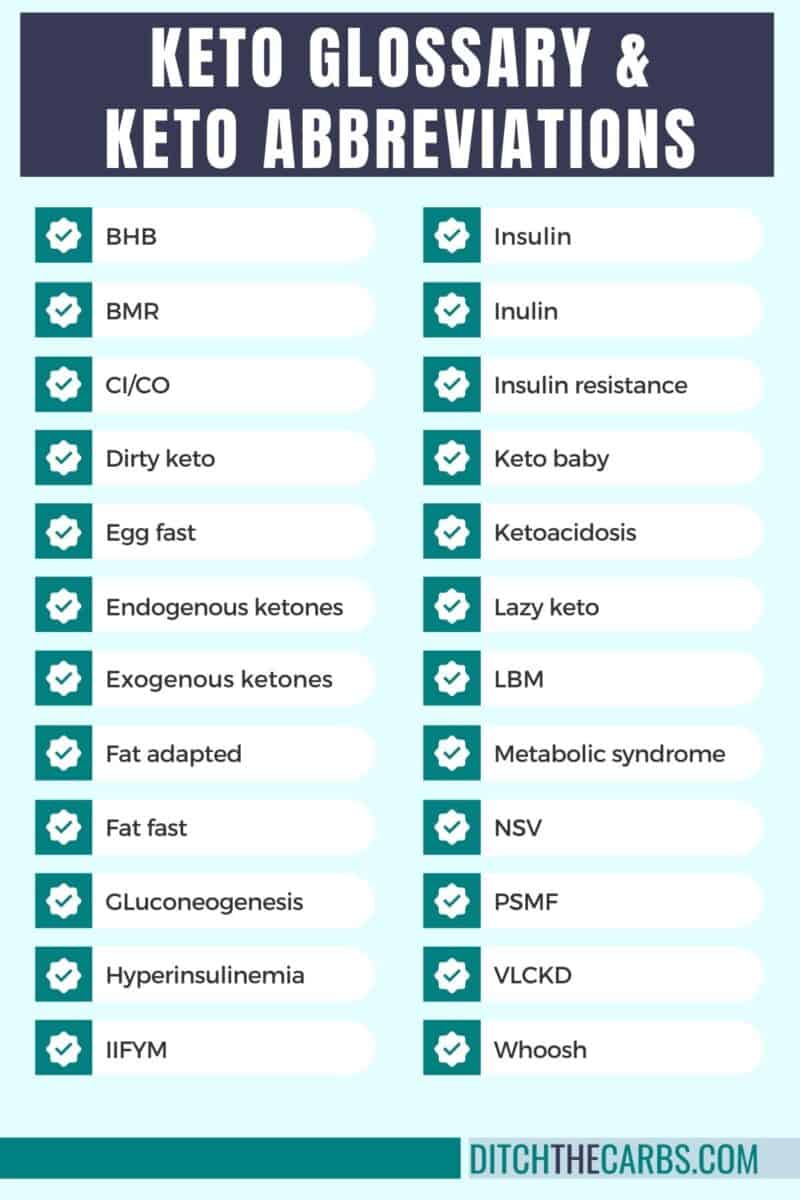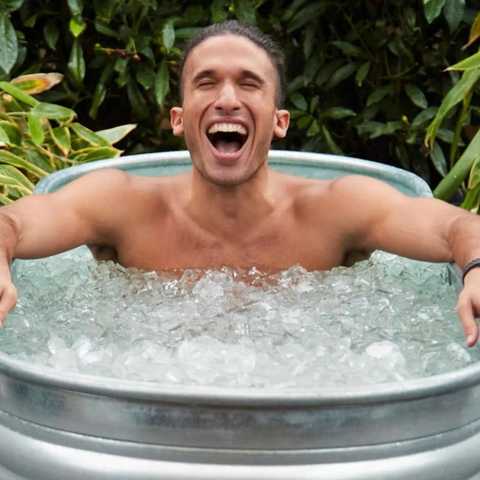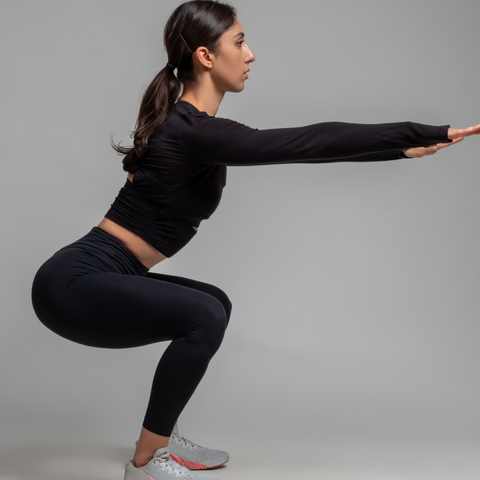Unfortunately, unless you’re using spicy supps, your body cannot consistently support that type of volume, especially long-term. Of course, you can go hard occasionally, but you need some rest days every week during your typical training cycle.
Just because it’s a rest day doesn’t mean you do nothing. Instead, you should be involved in active recovery to optimize your rest days. An active recovery workout is a day that uses low-intense exercise to give your body better recovery and more progress.
- What is active recovery?
- Why do we need to have a recovery day?
- What causes sore muscles and DOMS
- Benefits of active recovery
- Active recovery workouts
- Active recovery tips
-
Active recovery vs. passive recovery
If your rest days consist of watching Netflix on the couch, you need to read this article!
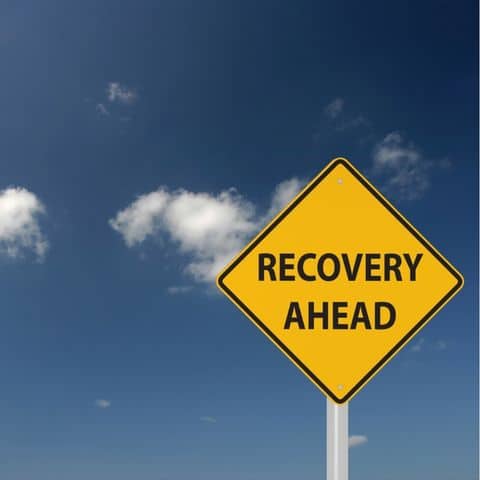
What Is Active Recovery?
In short, active recovery means doing low-intensity exercise to improve your recovery. We’ll address this in detail for the rest of the article including why active recovery is important, the benefits, sample workouts and tips.
Why is Active Recovery Important?
Before we start talking about active recovery and passive recovery, we need to discuss why we even muscle recovery. Why can’t we train every day?
It’s essential to realize why we need to recover to understand why you should take it seriously. In reality, recovery plays a massive role in training and plays an intricate part in progression.
Strength Training = Muscle Damage + Muscle Recovery
Any weight training, whether hypertrophy or strength training, involves a continuous cyclical progression.
When you go to the gym, your main goal is accumulating more volume with heavier loads AKA progressive overload. Unfortunately, this will create muscle damage.
You then go home to eat, sleep and recover. During this time, your muscles experience something known as “super-compensation.” Because your body wants to prepare itself for next time, it will adapt to this new stimuli by repairing itself but a little bit bigger. This is also why you must continually load your body more to ensure consistent growth.
In short, the cyclical pattern looks like this:
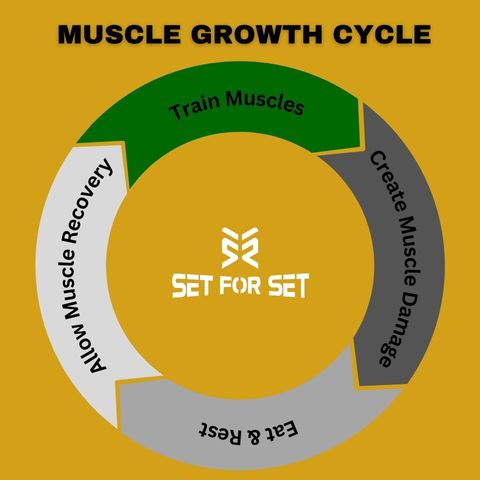
Too Little Recovery Time Doesn’t Allow Growth
While it would be great to train every day, this is only feasible sometimes. And no, it has nothing to do with dedication or laziness; your body cannot recover from the extensive muscle damage daily.
When you don’t allow proper recovery time, your body cannot complete that step of the cyclical pattern. In other words, you go back to the gym with muscles that are only partially repaired.
As a result, you’re unable to train with maximum effort. While you probably feel like you’re training hard, your body works on the physiological level, not feelings. In other words, you keep pulling your muscles back when they’re trying to progress.
Why Can’t You Train Every Day
As you see, taking a day off isn’t being weak; it’s necessary. If you’re training hard every day, you likely aren’t training as hard as you think you are. This might be because you don’t fully understand how to follow a training schedule or simply cannot.
This is one of the primary ways anabolic steroids work. They allow you to place massive amounts of stress on your muscles while giving them the ability to recover faster and bigger. However, if you’re not using them, you do not have the physiological means to train hard every day, at least not effectively.
You Need Rest Days!!!
Training too much is often a common problem qualified trainers see when getting new clients. It’s not uncommon to see guys training 6-7 days a week hard for 2-3 hours and sometimes even twice a day on multiple muscle groups.
They then believe they’re not progressing because they’re not training hard enough and want more exercise! Exactly how much more can you train!? While we understand why they’re hesitant when they hear they need less training, the ones who listen usually see massive improvements in their performance, aesthetics, and mental health.
What Causes Sore Muscles
Learning about what causes sore muscles may surprise you. That’s because sports researchers aren’t completely sure. While there are theories, some better than others, an explanation for muscle soreness remains a bit of a mystery.
To be clear, we are talking about the mechanisms of muscle. We know that intense exercise like, high-intensity interval training or any high intensity exercise, is the primary reason. However, we’re not sure what intense workouts do to make the muscles sore. Common explanations are:
- Muscle damage
- Buildup of metabolites
- Inflammation
The most likely cause is a mixture of muscle damage and inflammation. With that out of the way, let’s get into the benefits of active recovery.

Benefits Of Active Recovery Sessions
We firmly believe that active recovery is what you should do on your recovery days or even your training days. Again, active recovery is when you engage in physical activity to optimize your recovery. Instead of just going home and hoping your body does a good job of repairing your muscles, active recovery enhances your body’s natural healing abilities.
The main difference between active and passive recovery is the mode used to encourage repair. Passive recovery also involves activities to enhance your rest days but relies on various tools like massage guns or foam rollers.
Regardless, here are some reasons you’d want to start including active recovery workouts in your normal routine. We’ll also touch on a few “benefits” that aren’t as solid as some studies would have you believe.
1. Increase Blood Flow To Deliver Nutrients
One of the primary mechanisms that make active recovery one of the more effective forms of post-exercise recovery techniques is it increases blood flow. Our blood is the mechanism that transports fresh oxygen and nutrients to our muscles. So, theoretically, increased blood flow will bring more fresh blood to your muscles.1
2. Reduces Pain And Soreness
One interesting thing about light exercise is it can produce an analgesic response.2 Perhaps through the release of chemicals or regulation of pain receptors, getting a light pump can decrease smaller levels of pain.
While pain relief seems to occur near the training, it can theoretically prevent a “buildup” of pain. For example, the discomfort will build and build if you do nothing. However, repeated bouts of active recovery may still keep the peak of pain down.
3. Keeps Muscles Loose
Keeping your muscles “loose” is a term to describe your muscles and joints when they’re pain-free with a full ROM. Unfortunately, after we work out, we place a lot of damage on the muscles, as mentioned. This creates pain and discomfort.
In addition, the muscles and other tissues will become inflamed. All combined, moving your muscles through a full range of motion can be very difficult, not to mention doing it pain and discomfort free. However, as active recovery keeps the blood flowing and reduces pain, moving with your normal range of motion is much easier.
4. Allows You To Pursue Hobbies
One of the best parts about having active rest days is that they allow you to engage in hobbies, assuming your hobby isn’t sleeping (Sleeping is the best form of recovery but passive!).
Sometimes people avoid active recovery workouts because they think it means they are going to be bored or that they can’t do what they like. That’s fair enough, as not everyone wants to walk for a prolonged time. However, perhaps you can go surfing or a long kayak paddle. Any activity that gets your blood flowing and elevates your heart rate could be considered active recovery.
5. Maintains Training Schedule
As mentioned, many people don’t like the idea of recovery days as they feel like they’re not doing anything. These individuals enjoy a tough workout and the grind of training, so when told to recover, the idea of not going to the gym can be off-putting. An active rest day can solve this.
Placing active recovery workouts in your normal routine can give you the rest you need while keeping up the training momentum. Further, while you might love an intense workout, you may be surprised that low-intensity exercise can provide similar sensations once the blood flow starts moving.
6. May Reducing Lactic Acid Buildup
Hold on for this, as there are a lot of nuances to address. Blood lactate is a by-product of fast glycolysis and has long been associated with muscle fatigue and that burning sensation you’re familiar with during your intense workouts.
However, recent research has shown this not to be the case. In fact, lactate can be used for energy. The reason it’s associated with muscle fatigue because during fast glycolysis, an excess amount of hydrogen ions are created. These ions buildup and cause the blood pH level to drop, making it acidic.
So while there is an association between muscle fatigue and blood lactate, studies have shown that the clearance removal rate has very little effect on successive performance or the presence of DOMS (delayed onset muscle soreness).
7. May Improve Performance
Another claim is that active recovery will improve your performance. Again, we say it will, but there’s some nuance to address.
Regarding athletic performance, active recovery doesn’t seem to necessarily provide benefits, at least consistently. However, remember that there are so many different variables to test.
We feel that it will help progression from the fact you just feel better. In addition, studies have shown that it can relieve discomfort, which can help you be more consistent in your training.
Further, other studies suggest that there does seem to be a factor of variability between individuals. For example, these researchers report that active recovery produces better results in some athletes than others.3 In other words, if it works for you, then it works.

The 3 Best Active Recovery Workouts
There are a ton of ways you could perform an active recovery workout. Just about anything that increases blood flow could work. Most research will give a broad range of intensity, at least when using steady-state cardio, of 10-30 minutes of 30-60% intensity.4
However, we like to use our active recovery days to practice other fitness variables when possible. So here’s a list of awesome ways to spend your active recovery day.
1. Going For Brisk Walk
The easiest form of active recovery is a simple brisk walk. It’s a low-intensity steady state exercise that checks all the boxes for active recovery.
- Increases heart rate
- Increases temperature of skeletal muscles
- Involves all limbs going through some ROM
What makes a brisk walk such an efficient form is that you can do it anywhere. Whether in the city, on an open field, or trapped in a room, nothing can stop you from getting some steps in.
In addition, we recommend you walk outside if possible. Getting out in nature brings about its unique benefits as well. For example, studies have shown that time outside causes a natural boost in mood and can even fight depression.
Because walking is so easy to do, we recommend it be a daily activity, even for just 20 minutes. When walking, remember that it must be “brisk.” There’s no clear-cut distinction for what “brisk” means, so it should be faster than your normal or natural speed. Further, try using as much ROM as possible in the arms with the arm pump.
2. Take A Nice Recovery Swim
Swimming is an awesome form of recovery. A recovery swim brings many unique benefits that can’t be found elsewhere.
It’s a full-body exercise that will train every muscle in the body. Then, as you’re floating in the water, there’s no extra impact on the joints, making it perfect for anyone with issues.
The only issue with swimming is that a good amount of skill must be accounted for, at least for swimming competitively. When doing a recovery swim, there’s no need to worry about perfect strokes or proper breathing.
Getting in the water and swimming around however you want is perfect. Further, because swimming is so challenging, it’s impossible not to swim at high enough intensity. To be clear, we always encourage people to learn new skills and practice techniques. However, for recovery, some classic doggy-paddle will do the trick.
3. Mobility Exercises
Most people hate doing mobility exercises, but they also really need them. Sure, some may find it boring or feel like “you’re not doing anything,” but this makes active recovery days so awesome. You can feel productive as you recover.
We want to be clear and distinguish mobility exercises from stretching, especially static stretching. The primary focus of stretching is to loosen up your muscles and tendons to improve mobility. While some will expand this to mean increased ROM, it primarily concerns “stretching” the muscle.
On the other hand, mobility refers to the joint’s ability to move freely through an entire range of motion. In addition, along with others, we like to add a strength component. While we’re not talking about using heavy loads and setting PRs, true mobility means you can create force through a wide range of motion pain-free. Resistance band mobility exercises are an awesome way to add to your active recovery training sessions.
For example, getting into a deep squat is one thing. Being able to get ass-to-grass with a load on your back problem free is another. Regardless, true mobility work can be challenging enough to satisfy the need to work.
3 Tips For Your Active Recovery
Here are some general tips on utilizing the various active recovery workouts on your active rest days.
1. Use Steady-State Cardio For Shorter Sessions (Except Swimming)
These are for your daily sessions post-workout. We like using steady-state cardio because it’s easy, and you can start immediately. However, even though something like a mobility workout is “low intensity,” it still requires some warm-up before you start. Therefore if you only have 20 minutes, taking 5 minutes to warm up doesn’t make sense.
Speaking of swimming, while technically it’s steady-state cardio, it requires extra time to get to a pool and prepare. Compare that to walking, where you can walk outside and go. But, again, these are just tips and what we would do.
2. Save Mobility Workouts For Entire Session
We strongly recommend you use at least one day to run a full mobility workout. You could combine some steady-state cardio as well. In reality, you need to warm up anyway, so something like 20-30 minutes of steady state and 30-40 minutes of mobility. For those that have steel maces check out this post that covers everything you need to know active recovery with steel maces.
3. Catch Up On Netflix!
We weren’t going to forget about Netflix!
We get it. Sometimes walking on a treadmill for an excessive amount of time doesn’t appeal to everyone. While we generally like to be in the moment when we train, this rule doesn’t apply to active recovery, at least the low-intense cardio aspect.
One amazing thing about cardio equipment like manual treadmills or elliptical machines now is that they may come with screens and Wi-Fi ability; some even have direct access to NetFlix! If not, you can easily bring a tablet or even your phone. So now, you can let your mind get sucked into the latest series while performing muscle recovery!

Active Recovery Vs. Passive Recovery Vs. Off Days
Now that you know taking a recovery day can improve your exercise performance, you have a few options for what you’re supposed to do.
- Active Recovery
- Passive Recovery
- Off Days
This article is about active recovery, so we’ll review the other two options.
What Is Passive Recovery?
Passive recovery is a method of post-exercise recovery that does not rely on exercise performance or physical exertion. It uses external stimuli to enhance recovery. Some of the more common methods are:
- Self-myofascial release
- Foam roller
- Massage guns
- Heat therapy
We understand that some people will categorize these as active recovery. While they involve actively optimizing your recovery, we feel there should be a distinction between doing bear crawls across the floor and sitting in a recliner with compression sleeves around your legs. Check out some ideas of the best foam roller exercises or the benefits of heat therapy to help with your passive recovery.
What Are Off Days?
Off days are just that. Off.
While this doesn’t mean you have to sit in bed all day long, you could if you wanted. But, more importantly, if you do go out to enjoy the day, you shouldn’t do anything with the intent of doing exercise. It means do whatever you want as long as it’s not training.
Off days provide complete muscle rest and give your mental health a nice break. We encourage trainees to try and do nothing fitness related, including thinking about fitness.
Sitting at home as you watch a movie, wondering if you’ll lose your gains defeats the point. You would be surprised by how rare it is for trainees to do this.
How Often Should I Have A Recovery Day?
The answer to this largely depends on how many rest days you have. Unless you’re using spicy supps, we don’t think anyone needs to train more than 5 days a week, with 4 being optimal for most people. This means you have 2-3 rest days available to you.
We firmly believe everyone should use at least one rest day as an off day. And yes, ideally, this would include doing sports as well. But, again, this doesn’t mean you need to be lazy; we understand the people who want to be active daily. However, many probably don’t realize how much having one day a week to do nothing can do for mental health.
Also, remember you can perform active recovery without making it an active recovery day. For example, lifting weights in the AM and going for a brisk walk in the PM.
You can (should) use these smaller active recovery workouts most days. This has greatly impacted how we feel physically with our training.
So all this said, assuming your training schedule has 2-3 rest days, you should:
- Have at least one off day.
- Have at least one active rest day with a full active recovery workout. These should be 45-60 mins.
- Use smaller active recovery sessions 3-5 times as able. These can be anything from 10-20 mins.

Summary Of Active Recovery
Everyone loves a tough workout, but you need to turn it down a notch to get the most out of it. Active recovery is popular in the fitness industry because it is effective. Further, the average lifter has become more knowledgeable about recovery’s massive role in their progression.
Now that you know a lot more about active recovery, make sure you check out our post that covers tips to avoid overtraining.
- Tufano, James J., et al. “Effect of Aerobic Recovery Intensity on Delayed-Onset Muscle Soreness and Strength.” Journal of Strength and Conditioning Research, vol. 26, no. 10, Oct. 2012, pp. 2777–82, doi:https://doi.org/10.1519/jsc.0b013e3182651c06.
- Zainuddin, Zainal, et al. “Light Concentric Exercise Has a Temporarily Analgesic Effect on Delayed-Onset Muscle Soreness, but No Effect on Recovery from Eccentric Exercise.” Applied Physiology, Nutrition, and Metabolism, vol. 31, no. 2, Apr. 2006, pp. 126–34, doi:https://doi.org/10.1139/h05-010
- Ortiz, Robert O., et al. “A Systematic Review on the Effectiveness of Active Recovery Interventions on Athletic Performance of Professional-, Collegiate-, and Competitive-Level Adult Athletes.” Journal of Strength and Conditioning Research, vol. 33, no. 8, Aug. 2019, pp. 2275–87, doi:https://doi.org/10.1519/jsc.0000000000002589.
- https://www.researchgate.net/profile/Christoph-Schneider-2/publication/321874700_Effects_of_active_recovery_on_muscle_function_following_high-intensity_training_sessions_in_elite_olympic_weightlifters/links/5e7b0e9f92851cdfca2f6c4b/Effects-of-active-recovery-on-muscle-function-following-high-intensity-training-sessions-in-elite-olympic-weightlifters.pdf



















